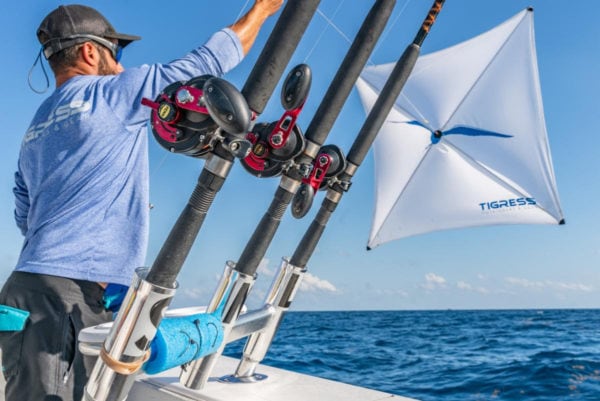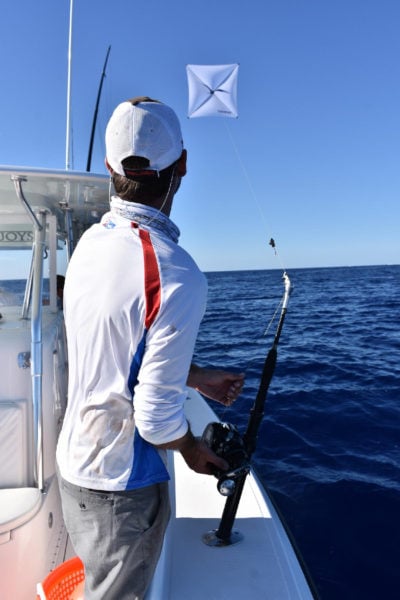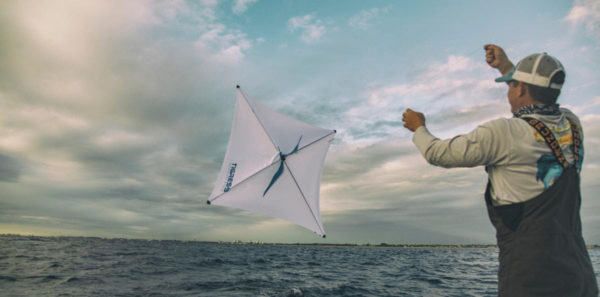Kite Fishing 101 with Tigress Outriggers & Gear
Category: article
Mar 22nd, 2022 by Keith Worrall
Modified Mar 22nd, 2022 at 11:30 AM


Lake Worth, Fl. (March 22, 2022) – Kite fishing is one of the most productive and exciting ways to catch fish. Using a kite to keep baits thrashing on the water’s surface rings the dinner bell for bluewater predators from incredible distances, and results in some of the most heart pounding strikes you’ll see anywhere. Though it’s usually associated with sailfish, the technique catches marlin, tuna, wahoo, and even mahi from Norcal to Nova Scotia.
Kite fishing is so successful because of the way it presents baits seductively near the surface without any terminal tackle in the water to give away the game. The bait is suspended by the kite, with only the tantalizing motion of the baitfish visible to the predators below. This stealthy approach gives you an edge in even the most pressured fishery.
The kite shares some lineage with the ones you flew as a kid, but are specialized designs built to carry a payload of one or more baits in the often rough conditions offshore. Built of lightweight and rugged materials, there are kites tuned to fly correctly in anything from light to high winds. On almost windless days, helium balloons can be employed to provide additional lift to keep the kites flying.
You don’t need a lot of specialty equipment to get your boat ready to kite fish, but you can never have enough rod holders. You’ll want to keep all the rods that are fishing baits on the same kite clustered close together. If your boat isn’t so equipped, get one of the adapters that go into one of the existing rod holders and increase their capacity to three or more.

The kites are connected to the boat via a braided line of anywhere from 50 to 100 pound test, corralled by a short rod with a single guide and reel. The line features release clips, similar to the ones you find on outriggers, evenly spaced out. Each clip will hold a line from a 25 to 40 pound class outfit, attached to live bait. Experienced skippers will fish as many as six lines per kite, but three are most commonly used.
The reels on the outfits you’ll use to battle fish should be filled with 20-pound mono topped off with a 30-foot long shot of 40 to 50 pound fluorocarbon. A ceramic ring is added to the line to prevent chafing when it goes into the release clip, and a weighted kite line marker is fitted to the end to increase visibility and help keep it perpendicular.
You can use just about any live bait with a kite, so the choice will depend on the species you’re pursuing. Goggle eyes, threadfin herring, flying fish, ballyhoo, butterfish, pilchards, small mahi and even bluefish can be all suspended. Whatever bait you choose, rig it with a bridle to keep it livelier. The hook point is exposed, which leads to a better hook set. Use a circle hook, and add a short trace of wire if you’re going to encounter toothy species.
When you see a fish rise to a bait—and you will see it—be certain to keep the bait right on the surface to ensure the leader doesn’t tangle on itself. Put the reel in free spool and keep it there until it completely swallows the bait. Once it’s been gulped down, point the rod tip at the release clip and reel as fast as you can. The clip will pop open and dump a bunch of slack in the process, which you need to take up as quickly as possible. Then just hang on and enjoy the ride.

For more information, please visit www.tigressoutriggers.com.